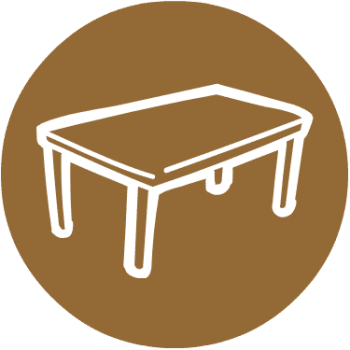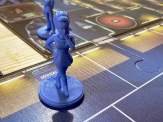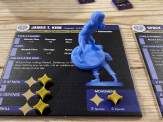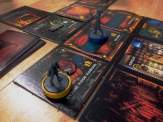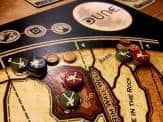| Release Date: 2023 | Players: 2 (only) |
| Designer: Andrew Haught, Mike Haught, Phil Yates | Length: 60-90 minutes |
| Artist: Henning Ludvigsen | Age: 10+ |
| Publisher: Gale Force Nine | Complexity: 2.5 / 5 |
| Plastic (by weight): 10% | Air (by volume): 20% |
After the battle of Wolf 359, the team consisting of Commander Riker, Lieutenant Commanders Data and Shelby and Lieutenant Worf on board the U.S.S. Enterprise were doing all they could to protect the ship against the invading Borg, led by Locutus of Borg, formerly Captain Picard of the Federation. It was a strange situation. The alien drones seemed oblivious to the starship’s crew as both sides went about completing their objectives and overall missions. Our training kicked in and it was as if we were on Star Trek: Away Missions by Andrew Haught, Mike Haught and Phil Yates from Gale Force Nine.
Listen to the Audio Version
Intro Music: Bomber (Sting) by Riot (https://www.
Music: Mars Is Burning by Benvibrant (from Pond5)
To Boldly Go…
I have been trying to find my way into the huge section of our hobby which is known as tabletop skirmish games. Now, I’m not a mini painter. I’m also not a fan of measuring gauges and complicated line-of-sight rules. I am more of a traditional board gamer at heart. So when I saw that Gale Force Nine‘s Star Trek: Away Missions is basically a traditional two-player card-driven hand management game, but with plastic miniatures that you move around a modular board divided into sections for easy movement, I just had to try it – and I was not disappointed.
The rulebook does take a little time to digest, if you’re new to tabletop skirmish games, but in reality, it’s not much you have to learn. There is a fair bit of dice-rolling involved. So you have to understand how attack and defence dice are resolved and remember a few numbers. You also have to remember that players take turns activating one of their characters, with each one carrying out two actions on their turn. Overall though, it’s not actually that difficult to learn what’s necessary, even though I did have to refer back to the rulebook a fair bit on my first few games.
What makes Star Trek: Away Missions so interesting are the decks of cards. These create the engine of the game. Moving around the board one space at a time is straightforward. Deciding if you can attack an opponent is also a breeze. The real fun begins when you play cards for actions, as upgrades or to stop an opponent from doing something. Cards can also be objectives that you’re trying to fulfil for points – and we all know what points make. The whole game centres around the cards.
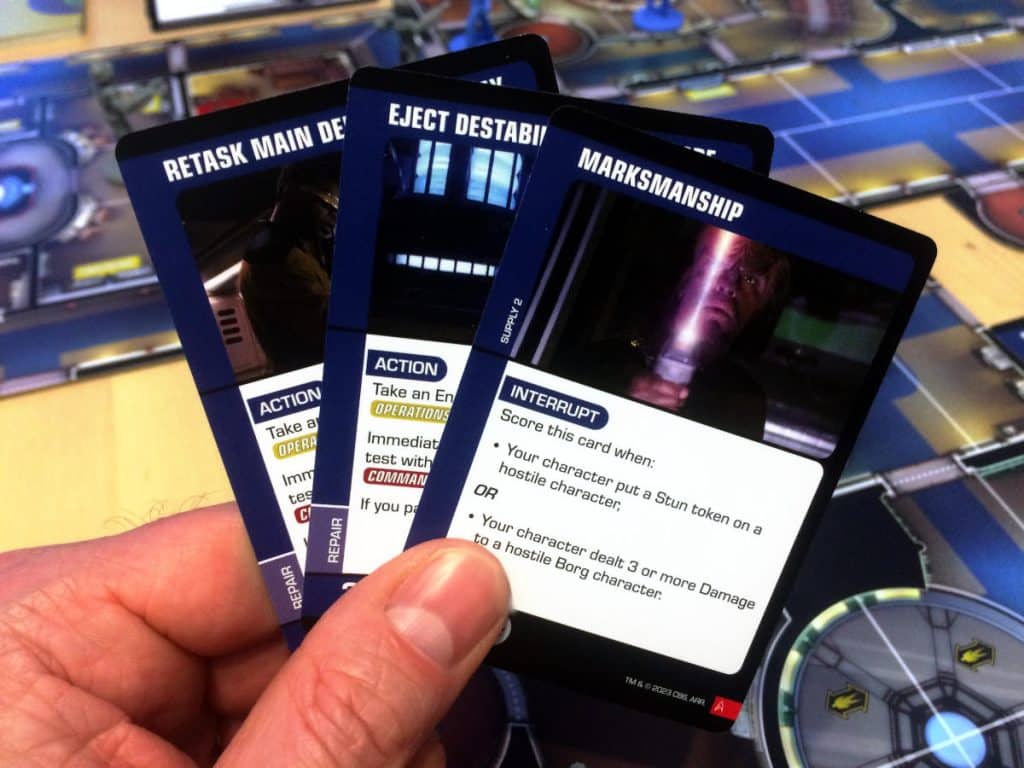
Primary Directive
For most of the game, you check your cards to decide what order to play them in, when to discard some and draw new ones, which wastes an action, but can be vital, or how to get to achieve your objective cards. You also need to ensure you have the right character in the right place. Each character has a specialization, which allows you to roll more dice when trying to complete certain challenges. Not only that, as one character gets wounded, their stats go down.
So while your team has an overall mission to complete, the objective cards are often more important. It’s all about tactics. You need to get the best out of the cards you’ve been dealt and the situation on the board as it presents itself to you when it’s your turn.
Like with most card games of its ilk, the more often you play Star Trek: Away Missions, the better you will know your deck. So from the start, you know what sections on the board are important to you, as well as those that your opponent values highly. You can plan much better and strategically place your characters to make it harder for the opponent to achieve what they need, while also protecting the areas that you need access to.
Engage
Setup is relatively quick, at least when you compare it to other tabletop miniature games. You set up the module board by placing the central corridor and attaching the four mission boards. It’s all double-sided, so you can either play on the U.S.S. Enterprise or the Borg Cube. You then take turns placing your characters. You also have to prepare the character boards, which need tiny little and very fiddly markers for the stats, and place a bunch of tokens to one side. Then players choose which of the two main missions they want to play during the game and you’re off.
As I said, there is a lot of dice rolling, as well as card playing. You roll for initiative to decide who goes first. You roll dice to resolve attacks and challenges. Working out how many dice you can roll is relatively straightforward. So, all in all, it’s not too bad.
The cards can also be a bit of a challenge. Deciding which one to play when is often tricky and as the board changes quite a bit from turn to turn, you often have to re-read the text to ensure you don’t miss anything. However, the more you play Star Trek: Away Missions, the less of a problem this is going to be. You’ll just get used to the cards and will know what they do just by their title.
I must admit though, I had to refer to the rulebook a few times to remind myself of certain things. Luckily, there is a good glossary at the back, so you can find things quite quickly. Overall, the rulebook is very good, with a lot of illustrations and examples. It’s just a lot to digest, if you’re new to the genre.
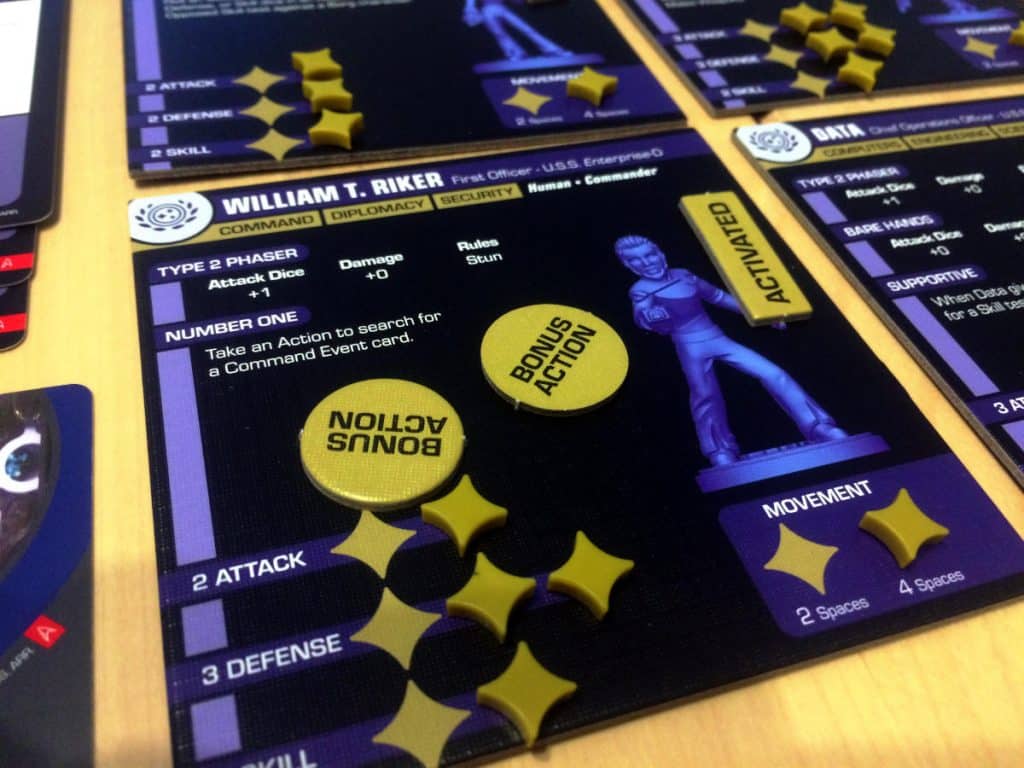
The Final Frontier
I really got hooked on Star Trek: Away Missions. It appeals to me as a board gamer who wants to get into skirmish games. I don’t have to worry about building my team or buying terrain. I don’t have to measure anything. I simply play my cards, roll the dice and move my characters across the board. I can see how that can be a turn-off for true tabletop miniature players, but for me, the simplicity of the gameplay is what appeals. I get my enjoyment out of playing the right cards at the right time and strategically moving my team around the board.
It’s good that Gale Force Nine were so kind to not only send me the base game, but also the Captain Kirk and Commander Scotty expansions. That means I can have many more adventures in the Star Trek universe. I wonder how the old guard would fare against the modern enemy of the hive mind. Well, keep an eye on the blog and you’ll find out. In the meantime, if my review has piqued your interest, I strongly recommend you beam some Star Trek: Away Missions onto your board game table the next time you’re at a space port.
For behind-the-scenes updates, branded merchandise, and more, please support the blog.
Useful Links
- Star Trek: Away Missions: https://www.
gf9games. com/ awaymissions/ 37/ star-trek-away-missions/ - Rulebook: https://www.
gf9games. com/ awaymissions/ wp-content/ uploads/ StarTrekAwayMissions_ Rulebook_ WEB. pdf - Gale Force Nine: https://www.
gf9. com/ - BGG listing: https://boardgamegeek.
com/ boardgame/ 384136/ star-trek-away-missions
Videos
Transparency Facts
I feel that this review reflects my own, independent and honest opinion, but the facts below allow you to decide whether you think that I was influenced in any way. Please also read my Ethics Statement for more information.- I was given a free review copy of this game by the publisher.
- At the time of writing, I have not received financial support from the publisher or anyone working on their behalf.
Audio Version
Intro Music: Bomber (Sting) by Riot (https://www.
Music: Mars Is Burning by Benvibrant (from Pond5)
Playlist
These are the songs I listened to while I was writing this review:
